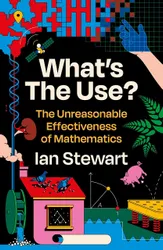This is a book about applied mathematics. It examines the idea that mathematics is “unreasonably effective” meaning that concepts and methods from one branch of mathematics can be usefully applied in seemingly unrelated areas. Often, the relevant mathematics was developed with no particular purpose in mind; the mathematicians involved were just exploring something they found interesting. Later, some branch of science or engineering needed some new maths to solve a particular problem, and the methods were rediscovered and applied. The book shows us several examples of this, describing how some area of mathematics works, and then showing us how that can be applied to solve a real-world problem. For example, we learn about the travelling salesman problem, which led to the development of graph theory. Then we find out how this can be used to help find chains of possible kidney donations from a large number of possible donors and people who need a new kidney, taking compatibility into account.
The book covers several mathematical areas, such as complex numbers, chaos theory, topology and graph theory. The range of uses they are put to is really extensive too. We get spring manufacture, voting districts, cryptography, climate change, 3D graphics and more. The book touches on calculus a bit, so a small amount of the content of this book overlaps with that covered in Infinite Powers, such as the CT scan. But it’s interesting to learn about it from a slightly different perspective.
There are lots of really great diagrams in the book to help with explanations. The maths is generally explained well, although there are times when the author mentions some concepts or uses some terminology that he hasn’t defined, and that I didn’t know already. This made some sections a little confusing and hard to follow for me. I really like to understand everything that I read as I go along, and there were times in this book when I couldn’t do that, which I found a bit frustrating. I did manage to get the gist of each example though, and at least the use of the correct mathematical terminology would give you the opportunity to read up on that area in more detail later if you’re interested. To be fair, it’s probably not possible to explain some of the concepts to a general audience in only a few sentences; most of the topics covered would require several books to do them justice! But it did hurt my enjoyment of the book a little.
That said, the author’s enthusiasm for his subject really shines through, and it boosted my enthusiasm for mathematics and the uses it’s put to in the modern world. The author makes a strong case for understanding maths, and the book gives the impression that following your curiosity and investigating interesting mathematical topics could provide useful results even though the application may not be immediately apparent. I find that a very appealing idea. All of the chosen topics are really fascinating and this book would give a budding mathematician a lot of jumping off points for further reading and study.
